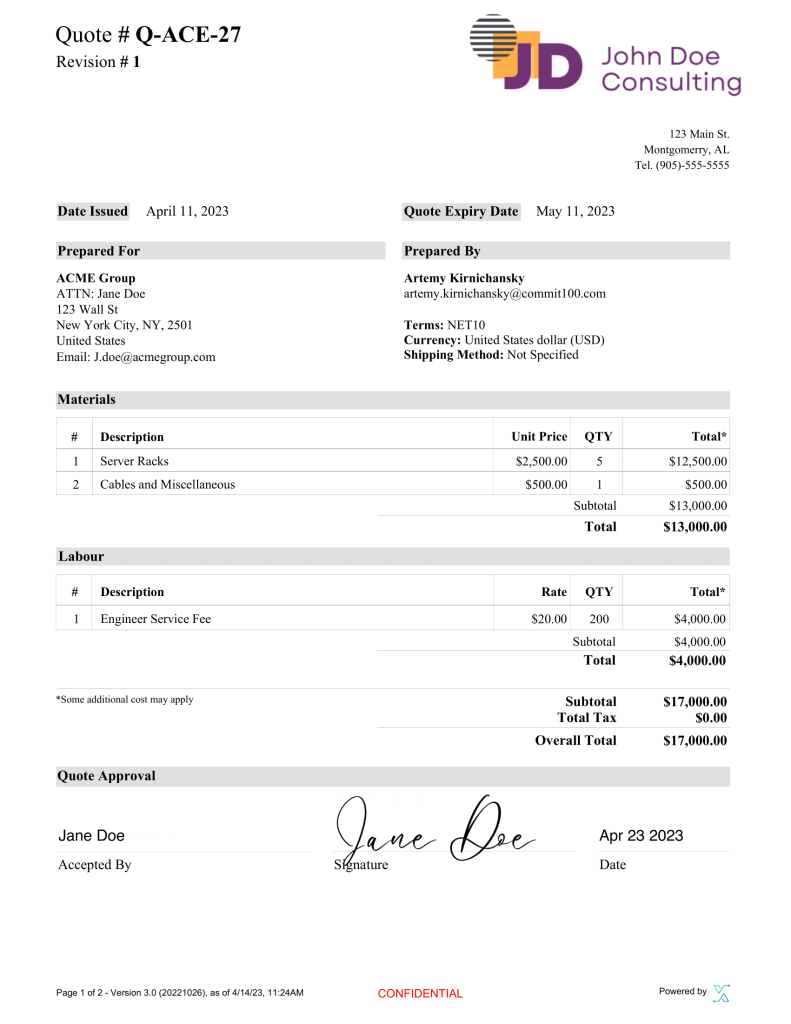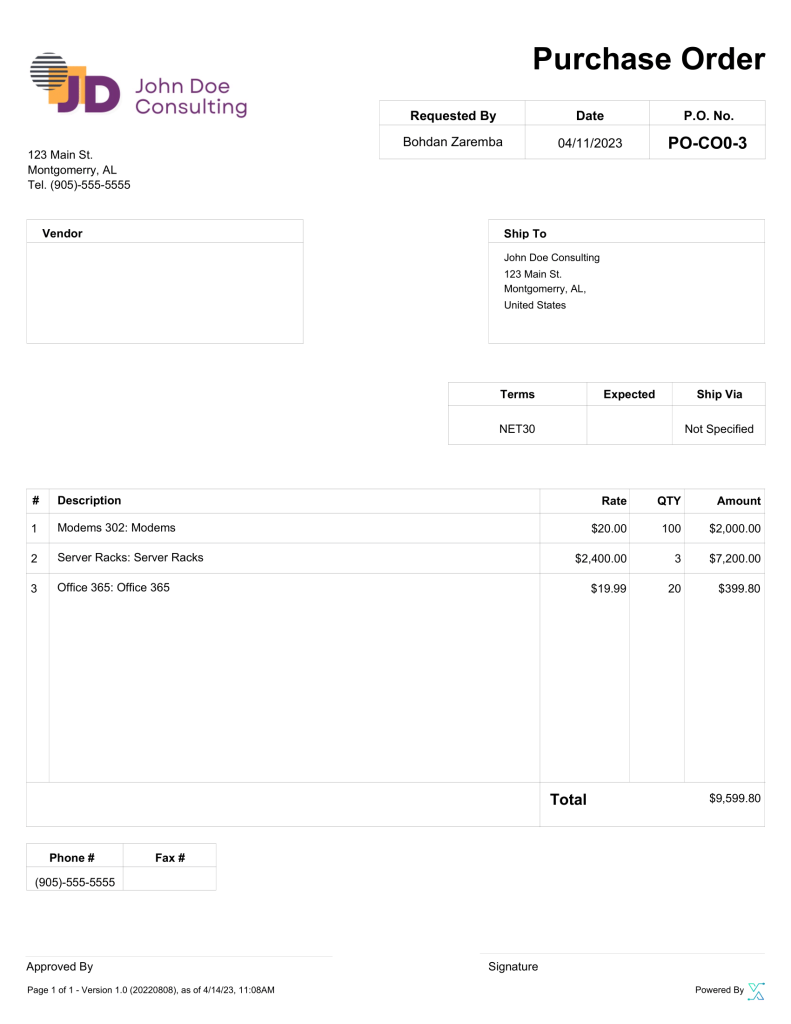Purchase order vs quote… what’s the difference?
At a first glance, they may seem similar because both are used in the buying and selling of goods and services. However, their roles, purpose, and functions are distinctly different. If you find yourself confused about the difference, don’t worry.
In this article we will carefully delve into the differences between Quotes and purchase orders.
What is a Quote?

A quote, also known as an estimate, is a document provided by a seller to a potential buyer. The primary function of a quote is to layout the seller’s proposed terms and conditions for a transaction. The details provided in a quote can be quite comprehensive and includes things like item descriptions, quantities, unit prices, total costs, delivery timelines, payment terms, and any other specific terms that may be relevant to the transaction.
Typically, a quote is prepared in response to a request for quote (RFQ) or a request for proposal (RFP) from the buyer. It’s designed to give the buyer a clear understanding of the costs and conditions involved, thereby enabling them to make an informed purchasing decision. However, it’s crucial to note that a quote does not bind the seller to the terms mentioned – it merely serves as an offer which the buyer can either accept or negotiate further.
Quotes Must-Have Items:
- Quotation Number
- Date of Issue
- Seller’s Company Name and Address
- Buyer’s Company Name and Address
- Detailed Description of Goods or Services
- Quantity of Goods or Services
- Price Per Unit
- Total Estimated Price
- Expiration Date of the Quote
- Terms of Sale
- Signature of Authorized Representative
Example of Using a Quote:
As a small retail business owner, you decide to introduce a new range of handmade soaps to your product line. You contact a local soap manufacturer and ask them for a quote for 500 bars of various types of soaps. The manufacturer sends you a quote detailing the type of soaps, quantities, unit price, total cost, and terms of delivery.
How to Make a Quote
You could spend the time in google sheets, or excel making your own quote template, but you risk making mistakes. Instead try our free quote generation tool to make a polished and professional quote in minutes.
Quotes vs. Estimates: A Brief Comparison
While both quotes and estimates are used in the initial stages of a transaction to provide an idea of potential costs, they have distinct implications. A quote outlines the seller’s firm commitment to provide goods or services at a specific price unless unforeseen circumstances arise. It serves as a fixed price offer that a seller is bound to once accepted by the buyer.
On the other hand, an estimate provides a rough approximation of costs. It’s more flexible and may vary based on changes in conditions or requirements. It’s important to understand the distinction to ensure clear and effective communication during the procurement process.
What is a Purchase Order?

A purchase order (PO), on the other hand, is a document issued by the buyer. Unlike a quote, a purchase order formalizes the buyer’s intention to purchase specific goods or services from the seller under agreed terms. It acts as a contractual agreement between the buyer and seller and, as such, includes more precise details, such as the buyer and seller’s contact details, item descriptions, quantities, agreed prices, delivery instructions, and payment terms.
The buyer creates a purchase order based on the terms outlined in the quote or after negotiations with the seller. Once the seller accepts the purchase order, it becomes a legally binding agreement. Therefore, a purchase order serves not only as a means of communication but also as a legal document that outlines the obligations of both parties.
Purchase Orders Must-Have Items:
- Purchase Order Number
- Date of Issue
- Buyer’s Company Name and Address
- Seller’s Company Name and Address
- Detailed Description of Goods or Services
- Quantity of Goods or Services
- Price Per Unit
- Total Price
- Delivery Date
- Payment Terms
- Shipping Method and Address
- Authorization Signatures
Example of Using a Purchase Order:
After reviewing the quote, you agree to the terms proposed by the soap manufacturer. You then generate a purchase order referencing the details from the quote and send it to the manufacturer. The purchase order includes the specific soaps you want, their quantities, the agreed prices, delivery address, and payment terms. By accepting this purchase order, the soap manufacturer agrees to supply the soaps as per the agreed terms, and a legal contract is formed.
How to Make a Purchase Order
Making your first purchase order can seem dauting, luckily for you we got you covered. Our free purchase order makes creating a purchase order, try it now and generate your first purchase order.
Purchase Order vs Quote: Summing it Up
In essence, the key distinction between a quote and a purchase order lies in their function and legal significance. A quote is an offer, a preliminary document that states the seller’s proposed terms and conditions. It provides the buyer with an understanding of what to expect and a basis for negotiation.
A purchase order, conversely, is an acceptance and formalization of these terms. It’s a document that serves as a legal contract between the buyer and the seller. A purchase order affirms the buyer’s intent to purchase and lays down the terms that have been agreed upon by both parties.
Understanding the differences between a quote and a purchase order is crucial for both buyers and sellers. It helps to ensure clarity in communication, efficient procurement, and a smoother transaction process, reducing the potential for misunderstandings and disputes.
FAQ
What is a quote in the procurement process?
A1: A quote, or an estimate, is a document provided by a seller to a potential buyer outlining the proposed pricing, terms, and conditions for a specific product or service.
Does a quote represent a legally binding agreement?
A2: No, a quote is not a legally binding agreement. It is merely an offer from the seller, providing an understanding of the costs and conditions involved.
What is a purchase order (PO)?
A3: A purchase order is a document issued by the buyer to the seller formalizing the buyer’s intent to purchase goods or services under agreed-upon terms.
Does a purchase order represent a legally binding agreement?
A4: Yes, once a purchase order is accepted by the seller, it becomes a legally binding agreement outlining the obligations of both the buyer and seller.
What’s the main difference between a quote and a purchase order?
A5: A quote is an offer outlining proposed terms, while a purchase order is a contract affirming the buyer’s intent to purchase under these or negotiated terms.

